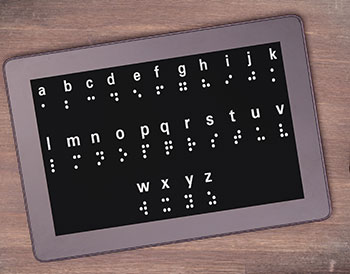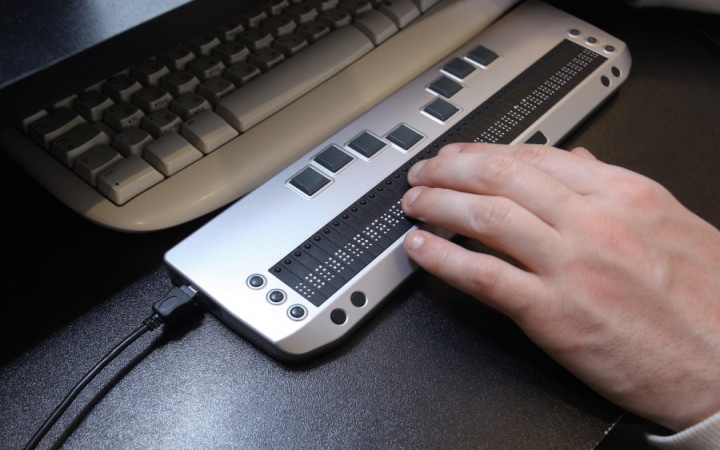Assistive Technology for the Blind: Innovations to Transform Lives
Assistive Technology for the Blind: Innovations to Transform Lives
Blog Article
Enhancing Lives With Advanced Assistive Instruments for the Blind
The integration of advanced assistive gadgets for the blind is transforming exactly how people experience their surroundings and interact with their communities. What does this advancement suggest for the future of assistive innovation and its duty in empowering individuals?
Summary of Assistive Gadgets
Assistive tools for the blind encompass a varied variety of modern technologies and devices developed to boost self-reliance and enhance the lifestyle for people with visual problems. These tools satisfy different needs, from navigation and movement to interaction and everyday task administration.
Among the primary categories of assistive devices includes flexibility help, such as white walking canes and overview canines, which help users browse their environments safely. Electronic traveling help, geared up with sensors and audio feedback, additionally play a substantial function in movement enhancement.
Additionally, tools that help with everyday living activities, such as adaptive cooking area tools, Braille tags, and speaking watches, empower people to do tasks independently. Interaction aids, consisting of display readers and Braille display screens, assist in access to details and allow individuals to involve efficiently with the electronic world.
Furthermore, low-tech remedies like amplifying glasses and large-print materials continue to be vital for several users. Collectively, these assistive devices offer not only as functional devices however also as essential enablers of freedom, fostering higher participation in a world that usually focuses on sighted experiences. Their assimilation into life is vital for promoting inclusivity and enhancing total well-being for those with aesthetic problems.
Innovative Technologies being used
Innovation in modern technology has dramatically transformed the landscape of tools offered for people with visual disabilities. Amongst one of the most noteworthy innovations are smart glasses integrated with increased reality, which supply real-time navigating support and object acknowledgment. These devices take advantage of progressed cameras and expert system to deliver auditory signs, boosting the user's spatial recognition and autonomy.
Furthermore, mobile applications have become powerful resources, allowing individuals to recognize money, reviewed text out loud, and browse unfamiliar environments through verbal instructions. Tools such as Braille displays and refreshable Braille devices continue to develop, using smooth connection with computer systems and smart devices, thereby enhancing communication and accessibility to information.
Wearable modern technology, including smartwatches outfitted with voice-activated functions, additionally equips individuals by assisting in fast access to notifications and alerts without requiring aesthetic involvement. Tactile maps and 3D printing are also gaining grip, supplying concrete representations of spaces that help in alignment and wheelchair training.
Collectively, these innovative technologies not just enhance the day-to-days live of visually damaged people however likewise foster greater independence, inclusivity, and engagement with the broader area, consequently reshaping perceptions of access. (Mobility aids for visually impaired users)
Individual Stories of Empowerment
Empowerment typically emerges from personal experiences that highlight the transformative impact of innovation on individuals with visual impairments. Take, as an example, the story of Sarah, a young artist that regained her interest for painting with making use of a wise walking cane geared up with barrier detection. This gadget not just facilitated her wheelchair but instilled a newly found confidence, permitting her to navigate public spaces independently and seek look at this now her imaginative ventures.

These stories highlight the extensive impacts that progressed assistive devices can carry day-to-day live. By making it possible for individuals to get over barriers, modern technology fosters a sense of freedom and self-respect. Such empowerment tales act as a testimony to the potential of advancement, illustrating exactly how the right devices can considerably boost lifestyle and open doors to brand-new opportunities for those with visual disabilities.
Advantages of Advanced Solutions
How can advanced services essentially improve the lives of people with visual disabilities? The combination of sophisticated modern technology right into assistive tools dramatically changes day-to-day experiences for those influenced by vision loss. These innovative remedies supply extraordinary freedom, making it possible for customers to browse their environments with confidence. Tools such as wise walking canes furnished with sensing units, navigating applications, and wearable innovation are developed to supply real-time comments, enhancing spatial awareness and reducing the threats connected with wheelchair.
Additionally, advanced assistive innovations foster social incorporation by helping with interaction and interaction. Voice-activated gadgets and applications enable people to access info and involve with their surroundings individually, breaking obstacles that formerly hindered their involvement in instructional, professional, and social setups.
Furthermore, the personalization and flexibility of these solutions accommodate the go now diverse requirements of individuals, thereby enhancing their total lifestyle. Improved capability, such as object recognition and text-to-speech abilities, encourages people with visual disabilities to do jobs that they might have when found challenging. Eventually, progressed assistive modern technologies not only improve self-reliance and security yet also promote dignity and self-respect, permitting customers to lead meeting lives.
Future Fads in Assistive Technology
As technology continues to progress, the landscape of assistive gadgets for the blind is positioned for exceptional advancements that will additionally improve access and independence. Emerging trends in assistive technology indicate a shift towards increased integration of expert system (AI) and artificial intelligence, making it possible for tools to adapt to specific user needs in real-time. These innovations are expected to facilitate even more instinctive navigating systems that can recognize challenges and give audio comments, significantly improving exterior flexibility.
In addition, the advancement of wearable tech, such as smart glasses outfitted with enhanced reality, will certainly enable users to receive contextual details regarding their surroundings, therefore enhancing their spatial awareness. Improvements in haptic technology guarantee to develop tactile responses gadgets, permitting individuals to regard info through touch, enhancing understanding and interaction with their setting.
Telecommunication advancements are additionally paving the method for remote assistance options, where trained experts can provide support via video clip calls, making sure assistance is readily easily accessible. As these trends unfold, the future of assistive devices for the blind will certainly cultivate better freedom, equipping individuals to navigate their world with self-confidence and simplicity.

Conclusion
The assimilation of sophisticated assistive devices for the blind stands for a considerable development in cultivating self-reliance and enhancing high quality of life. By utilizing cutting-edge innovations, these tools empower customers to navigate their settings with greater self-confidence and autonomy. As the field proceeds to develop, recurring r & d will likely yield a lot more innovative services, better transforming the lived experiences of people with visual disabilities and promoting a better feeling of incorporation within society.
The assimilation of sophisticated assistive gadgets for the blind is changing just how people experience their surroundings and engage with their areas. The integration of advanced innovation right into assistive tools significantly transforms everyday experiences for those influenced by vision loss.As modern technology continues to evolve, the landscape of assistive tools for the blind is poised for remarkable innovations that will certainly even more improve access and independence. Emerging trends in assistive technology indicate a shift toward boosted assimilation of artificial intelligence (AI) and device discovering, allowing gadgets to adapt to private user needs in real-time.The integration of advanced assistive tools for the blind stands for a significant development in fostering independence and enhancing quality of life.
Report this page